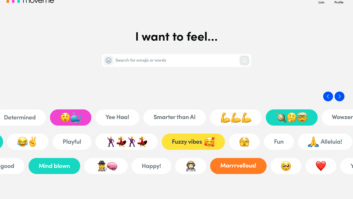The evolution of the broadcasting industry continues to gather pace. In recent years, we have seen a huge number of changes in the way that media is produced, owned and distributed. The recent impact of the pandemic is yet another societal transformation which affects viewers’ behaviour and preferences.
Although viewing demand is at an all-time high, requirements for production are also increasing. Media organisations need to walk the fine line between developing the right volume of content and keeping budgets under control in a competitive industry. Utilising existing archives and ensuring production efficiency will be crucial for a sustainable future in TV, and many content creators are looking to AI solutions to help achieve this.
Not only do organisations need to develop more content, they also need to make sure it meets audience expectations in order to maximise ROI. When it comes to delivering tailored content, AI is a great tool. However, in order to use AI effectively, we need to take a step back and look at the complexity of consumer demand in more detail.
Great Expectations
Years ago, consumers were resolved to flick through a handful of channels and watch whatever was available to them. As the proliferation of choice grew so did expectations. The more items on the menu, the more consumers began to expect options which exactly suited their tastes.
As media companies develop more variety to meet the collective demands of their audience, consumers crave a simple set of options which are specific to them. On the surface it seems that consumers are pushing for more and more choice. But in fact, on an individual level what’s happening is the opposite. Consumers are searching for more and more simplicity. As expectations rise alongside content options, audiences are becoming frustrated by the volume of choice and the negative effect this has on ease of use.
Consumers are turning to Connected TV (CTV) to deliver all of their favourite content in one place. A Nielsen report found that in the US, “CTV usage remains well above pre-Covid-19 levels”. CTV provides unprecedented insights into consumer viewing habits, and access to a range of content is a key factor in providing rich data.
AI is Changing Production
Collectively we have more information on viewer’s preferences than ever, but the challenge is utilising this information effectively. To revisit the menu analogy, an ideal result would be a tasting menu so bespoke it tailors flavours to each palette. In order to maximise engagement, content creators are certainly going to need some help in the kitchen.
Data is already moving back along the production chain to influence the type of content that media companies invest in producing. In future we are likely to see this process speed up. An audience can no longer be seen as a homogenous group and managing diversity within demographics will be vital for the future of content development.
The ability to track factors such as popularity, frequency and engagement are crucial to the long-term success of the broadcasting industry. As AI becomes more sophisticated, it will identify and predict what an audience wants more accurately. Leading to more and more production directed by viewing tastes.
Recent advances move beyond simply defining a genre. AI-based media management solutions can identify the emotions in a piece of content and tag it accordingly. It’s now possible to take mood into account, building a profile which responds to the way viewing habits change with an individual’s emotions.
Maximising Asset Management
With audience reactions, emotions and preferences leading the charge in content development, understanding and utilising media archives has never been more important. Many media organisations are integrating AI frameworks into huge, existing content libraries. AI metadata tagging makes valuable legacy assets highly searchable, without the need for time consuming manual tagging.
The speed at which information is disseminated means that broadcasters need to access content quicker than ever. Smart media management users can access ingested assets with pin-point accuracy. Short clips can be isolated from thousands of hours of footage within minutes, rather than days of manual searching. This is especially relevant for the 24-hour news cycle, where broadcasters need to respond to rapidly changing events with footage related to the story.
Some established broadcasters have delayed the transition to new asset management solutions and now find themselves on the back foot when it comes to utilising archived content. This is particularly pertinent within the current climate, given the types of production that can realistically be achieved with social distancing constraints in place. Throughout the pandemic, media organisations which had the ability to pull relevant content from their archives have been ahead of the curve when reacting to empty schedules.
Managing post production workflows is another area in which AI can make repetitive tasks more efficient. By automating editing workflows, post production teams can manage projects more effectively. Rather than waiting for assets, they can self-serve the content they need and collaborate on ideas without any roadblocks to the creative process.
Future Applications
In order to meet the demands of the market, media companies will need to live up to increasing expectations. It’s clear that AI can close gaps in the feedback loop between content consumption and content production. As well as reduce the menial tasks involved in post production, to maximise creativity and output. But AI must be used responsibly.
Data has now become a valuable form of currency, which of course raises questions of privacy. Media companies must comply with GDPR legislation, but as with any evolving technology it’s important to go beyond the basics. Overall consumers are happy for their data to be used when it simplifies their experience and improves their recommendations. They are less happy when the use of that data isn’t transparent. As AI technology advances, it must keep the end user at the heart of any implementation. In this way, media companies can ensure AI enriches rather than manipulates the viewer’s experience.
It’s argued that AI cannot replace cognitive judgement but in most broadcasting use-cases that’s not the intention. AI is simply a tool to free up production and post production teams to do what they do best, in the most efficient way possible. The need for human intervention won’t be removed, but a helping hand for companies delivering more content than ever before will certainly be welcomed. Broadcasters and media organisations need to react to the industry changes on the horizon and AI can give them a head-start.







